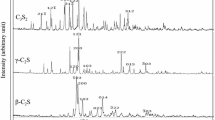Conclusions
Magnesite and magnesite-chromite powders obtained on the basis of beneficiated Satkinsk magnesite using the flotation method can be employed for making periclase-spinel refractories similar in quality to products of grade PShSO and PShSP. For such refractories there is typically an increased refractoriness under load of 2 kg/cm2, which on average equals 1640–1670°C.
The periclase-spinel products made from beneficiated materials contain 4–5% silicates instead of 8–12% in the refractories obtained from ordinary powders. In the high-temperature fired periclase-spinel refractories made from beneficiated materials we note the formation of high-quality structures containing about 50% direct intergranular bonds between the highly refractory minerals. In the structural elements of such refractories there is a predominance of intergranular bond of the type periclase-secondary spinel-periclase.
Similar content being viewed by others
Literature cited
V. A. Bron, Ogneupory, No. 7, 1–5 (1970).
K. V. Simonov and V. A. Perepelitsin, Ogneupory, No. 7, 9–15 (1969).
Author information
Authors and Affiliations
Additional information
Translated from Ogneupory, No. 2, pp. 10–14, February, 1973.
Rights and permissions
About this article
Cite this article
Bugaev, N.F., Zubakov, S.M. Periclase-spinel refractories from beneficiated materials. Refractories 14, 79–82 (1973). https://doi.org/10.1007/BF01295599
Issue Date:
DOI: https://doi.org/10.1007/BF01295599




